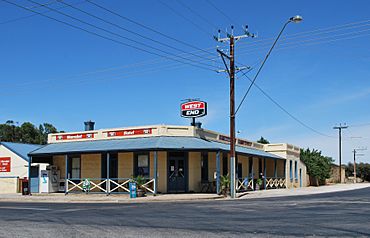Marrabel, South Australia facts for kids
Quick facts for kids MarrabelSouth Australia |
|
|---|---|

Marrabel Hotel
|
|
| Postcode(s) | 5413 |
| Location |
|
| LGA(s) | Clare and Gilbert Valleys Council |
| State electorate(s) | Frome |
| Federal Division(s) | Grey |
Marrabel is a small town in South Australia. It sits next to the Light River in a region called the Mid North. Marrabel is part of the Clare and Gilbert Valleys Council. It is about 100 kilometres (62 mi) north-west of Adelaide, which is South Australia's capital city. In 2021, about 101 people lived in Marrabel.
Contents
Marrabel's Early Days
First European Settlers
The first European to settle in the Marrabel area was William Peter. He arrived in early 1841. William Peter was a pastoralist, meaning he raised sheep and other animals. He had a special licence to set up sheep farms and shepherd huts in the area. His main farm was just east of where Marrabel is today. A nearby place called Peters Hill is named after him.
The River Light Special Survey
In December 1841, a group in London bought a large area of land. This land was known as the River Light Special Survey. Surveys were done in 1842 to map out farms and town areas. This old map still helps decide land borders today.
However, this plan for a new town didn't work out. Copper was found nearby in Kapunda in 1842. This discovery made everyone focus on Kapunda instead. Many people who invested in the River Light Special Survey lost their money.
Growing as a Stopover Town
In the late 1840s and early 1850s, Marrabel became an important stop. It was on one of the main routes to the Burra copper mines. Bullock teams, which were carts pulled by oxen, used to carry copper ore to Kapunda. Marrabel was a place where these teams could rest.
The land around Marrabel was very good for farming. This brought many farmers to the area. Because of the farmers, several small towns grew up to serve them, including Marrabel. In 1859, a local landowner named John E. Marrabel created a town on his land and named it after himself.
Marrabel grew quickly. By 1865, it had many important buildings. These included a hotel, several churches, a school, and two general stores. There were also two blacksmiths, a post office, and a flour mill that used steam power.
Marrabel's Recent History
Changes Over Time
Over the years, Marrabel has become smaller. This is mainly because transport has improved. People can travel more easily to bigger towns for services. However, Marrabel is still an important place for the local farming community. It provides essential services to the farmers in the area.
The Famous Marrabel Rodeo
Horses and other livestock have always been a big part of life in Marrabel. In 1935, the town started an annual rodeo. This event has been held every October since then and has become very popular.
One of the most famous moments in Marrabel rodeo history happened in 1953. A buckjumper named Alan Woods successfully rode a very difficult horse called Curio. This ride was so amazing that it became a legend. To remember this special event, a life-size statue of Curio and Alan Woods was made. This statue now stands proudly at one end of Marrabel's main street.
Marrabel Today
Today, the area around Marrabel is mostly used for farming, especially growing grain. The town still helps local farmers by providing important services. Marrabel is now famous across Australia for its yearly rodeo and bull ride.


